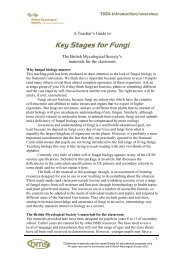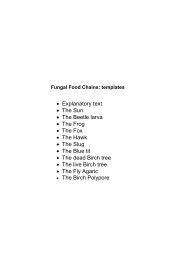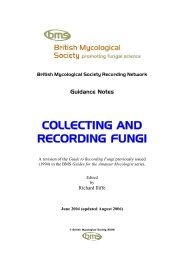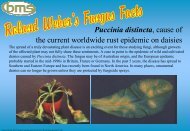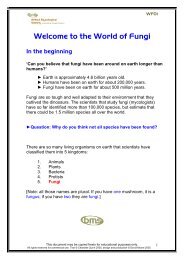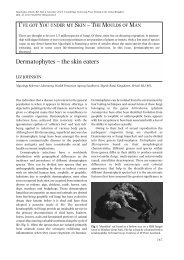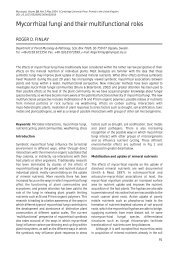Naturally bioluminescent fungi - Cambridge Journals
Naturally bioluminescent fungi - Cambridge Journals
Naturally bioluminescent fungi - Cambridge Journals
Create successful ePaper yourself
Turn your PDF publications into a flip-book with our unique Google optimized e-Paper software.
Mycologist, Volume 18, Part 1 February 2004. ©<strong>Cambridge</strong> University Press Printed in the United Kingdom.<br />
DOI: 10.1017/S0269915X04001016<br />
<strong>Naturally</strong> <strong>bioluminescent</strong> <strong>fungi</strong><br />
HEDDA J. WEITZ<br />
Department of Plant and Soil Science, School of Biological Sciences, University of Aberdeen, St. Machar Drive, Aberdeen<br />
AB24 3UU, UK. E-mail: h.weitz@abdn.ac.uk<br />
The Macaulay Institute, Craigiebuckler, Aberdeen AB15 8QH, UK.<br />
The natural phenomenon of bioluminescence is the<br />
emission of visible light by living organisms mediated<br />
by an enzyme-catalysed (‘luciferase’) reaction of<br />
molecular oxygen with a substrate (‘luciferin’).<br />
Bioluminescent organisms are diverse and widely<br />
distributed in nature, for example bacteria,<br />
dinoflagellates, <strong>fungi</strong> and insects. The luciferases show<br />
no homology to each other and the luciferins are also<br />
chemically unrelated. Molecular oxygen is the only<br />
common feature of bioluminescence reactions,<br />
indicating that the luminescent systems in most<br />
organisms may have evolved independently (Wilson &<br />
Hastings, 1998).<br />
In response to the article ‘Glowing Report’ in<br />
Mycological Dispatches (Mycologist 15/4, pp. 176), this<br />
note summarises what is currently known about fungal<br />
bioluminescence and what hypotheses have been<br />
suggested to explain this phenomenon.<br />
Relatively little research has been carried out on<br />
naturally <strong>bioluminescent</strong> <strong>fungi</strong> (reviewed by Harvey,<br />
1952; Wassink, 1978; Herring, 1994). There are<br />
currently thought to be more than 40 species of<br />
<strong>bioluminescent</strong> <strong>fungi</strong> within 9 genera, all of which are<br />
basidiomycetes (Wassink, 1978; Herring, 1994).<br />
Examples of luminescent <strong>fungi</strong> include Armillaria<br />
mellea (Fig 1), Mycena citricolor (synonym Omphalia<br />
flavida) and Omphalotus olearius (synonym Pleurotus<br />
olearius, Clitocybe illudens). Panellus stipticus is unusual<br />
in that luminescence is exhibited only by the North<br />
American strains of P. stipticus and not by the Eurasian<br />
strains (Peterson & Bermudes, 1992). Luminescence<br />
may occur in both mycelia and fruiting bodies, as for<br />
example in P. stipticus and O. olearius, or only in mycelia<br />
and young rhizomorphs as in A. mellea (Wassink,<br />
1978). Bioluminescent <strong>fungi</strong> emit a greenish light with<br />
a maximum intensity at 520-530 nm (O’ Kane et al.,<br />
1990). Some luminescent <strong>fungi</strong>, for example A. mellea,<br />
reportedly exhibit diurnal periodicity (Berliner, 1961;<br />
Calleja & Reynolds, 1970) and seasonal variation of<br />
bioluminescence (Kamzolkina, 1982). It is not known<br />
whether the biochemistry of the bioluminescence<br />
system of <strong>fungi</strong> is the same as that of other known<br />
systems (Wilson & Hastings, 1998). Fungal<br />
luminescence has been shown to require oxygen and in<br />
vitro light output has been characterised as an<br />
NAD(P)H-dependent luciferin-luciferase system for A.<br />
mellea and M. citricolor (Airth & Foerster, 1962;<br />
Kuwabara & Wassink, 1966; Kamzolkina et al., 1984),<br />
but not for P. stipticus (Airth & Foerster, 1964;<br />
Shimomura, 1989).<br />
Numerous reasons for the occurrence of<br />
bioluminescence in <strong>fungi</strong> have been suggested<br />
(Bermudes et al., 1992). One hypothesis suggests that<br />
the role of luminescence is to attract invertebrates to<br />
assist fungal spore dispersal (Sivinski, 1981, 1998).<br />
The presence of luminescence most strongly in the gills<br />
(e.g. P. stipticus) or spores (e.g. Mycena rorida var.<br />
lamprospora) may support this hypothesis (Bermudes et<br />
Fig 1 Photographs of Armillaria mellea ATCC 1113 grown on<br />
YM agar at 22°C in darkness for 3-4 weeks, taken in light<br />
(top) and darkness (bottom). The photographs were taken<br />
with a Nikon F3 camera and a Micro Nikkor 60 mm lens<br />
using a Kodak Ektachome 160T film. For the ‘bioluminescence’<br />
photograph (bottom), exposure was 16 hours in total<br />
darkness. (Photographs taken by David Riley, The Macaulay<br />
Institute)<br />
4
Mycologist, Volume 18, Part 1 February 2004<br />
al., 1992). Sivinski (1981) also discusses other possible<br />
reasons for luminescence that include the attraction of<br />
predators of <strong>fungi</strong>vores, the repulsion of negatively<br />
phototropic <strong>fungi</strong>vores, and as a warning signal to<br />
nocturnal <strong>fungi</strong>vores. There is some limited evidence to<br />
support these hypotheses but overall they remain<br />
unproven. Luminescence may not confer a significant<br />
selective advantage as there are both luminescent and<br />
non-luminescent strains of the same species and<br />
species that only have luminescent mycelium (Herring,<br />
1994). Another hypothesis suggests that<br />
bioluminescence is a by-product of a biochemical<br />
reaction and has no ecological value. Light production<br />
has been calculated not to be a significant energetic<br />
burden, and <strong>bioluminescent</strong> <strong>fungi</strong> may be releasing<br />
light (not heat) as an energy by-product of enzymemediated<br />
oxidation reactions (Herring, 1994; Fox,<br />
2000). For example, a relationship of bioluminescence<br />
to lignin degradation has been suggested where it may<br />
act to detoxify peroxides that are formed during<br />
lignolysis (Bermudes et al., 1992; Lingle, 1993). Many<br />
of the <strong>bioluminescent</strong> <strong>fungi</strong> are involved in wood and<br />
leaf litter decay, for example A. mellea and P. stipticus are<br />
white rot <strong>fungi</strong>. Cultural factors that have been shown<br />
to induce or depress the lignolytic system of other white<br />
rot <strong>fungi</strong> also affect the level of bioluminescence in P.<br />
stipticus (Lingle, 1993). However, a great deal of<br />
additional research still needs to be carried in order to<br />
explain the mechanisms and significance of the<br />
phenomenon of fungal bioluminescence.<br />
References<br />
Airth, R. L. & Foerster, G. E. (1962). The isolation of catalytic<br />
components required for cell-free fungal bioluminescence.<br />
Archives of Biochemistry and Biophysics 97: 567-573.<br />
Airth, R. L. & Foerster, G. E. (1964). Enzymes associated with<br />
bioluminescence in Panus stypticus luminescens and Panus<br />
stypticus non-luminescens. Journal of Bacteriology 88: 1372-<br />
1379.<br />
Berliner, M. D. (1961). Studies in fungal luminescence.<br />
Mycologia 53: 84-90.<br />
Bermudes, D., Petersen, R. H. & Nealson, K. N. (1992). Lowlevel<br />
bioluminescence detected in Mycena haematopus<br />
basidiocarps. Mycologia 84: 799-802.<br />
Calleja, G. B. & Reynolds, G. T. (1970). The oscillatory nature<br />
of fungal bioluminescence. Transactions of the British<br />
Mycological Society 55: 149-168.<br />
Fox, R. T. V. (2000) Biology and life cycle. In Armillaria Root<br />
Rot: Biology and Control of Honey Fungus, pp. 3-43.<br />
Andover, England: Intercept Ltd.<br />
Harvey, E. N. (1952) Bioluminescence, pp. 96-117. New York,<br />
USA: Academic Press.<br />
Herring, P. J. (1994). Luminous <strong>fungi</strong>. Mycologist 8: 181-<br />
183.<br />
Kamzolkina, O. V. (1982). Oscillation of bioluminescence in<br />
submerged culture of Armillaria mellea (Fr.) Kumm.<br />
Mikologiya I Fitopatologiya 16: 323-325.<br />
Kamzolkina, O. V., Bekker, Z. E. & Egorov, N. S. (1984).<br />
Extraction of the luciferin-luciferase system from the fungus<br />
Armillaria mellea. Biologicheskiye Nauki 1: 73-77.<br />
Kuwabara, S. & Wassink, E. C. (1966). Purification and properties<br />
of the active substance of fungal luminescence. In<br />
Bioluminescence in Progress (edited by F. H. Johnson & Y.<br />
Haneda), pp. 233-245. Princeton, USA: Princeton<br />
University Press.<br />
Lingle, W. L. (1993). Bioluminescence and ligninolysis during<br />
secondary metabolism in the fungus Panellus. Journal of<br />
Bioluminescence and Chemiluminescence 8: 100.<br />
O’Kane, D. J., Lingle, W. L., Porter, D. & Wampler, J. E. (1990).<br />
Spectral analysis of bioluminescence of Panellus stypticus.<br />
Mycologia 82: 607-616.<br />
Peterson, R. H. & Bermudes, D. (1992). Intercontinental compatibility<br />
in Panellus stypticus with a note on bioluminescence.<br />
Persoonia 14: 457-463.<br />
Shimomura, O. (1989). Chemiluminescence of panal (a<br />
sesquiterpene) isolated from the luminous <strong>fungi</strong> Panellus<br />
stipticus. Photochemistry and Photobiology 49: 355-360.<br />
Sivinski, J. (1981). Arthropods attracted to luminous <strong>fungi</strong>.<br />
Psyche 88: 383-390.<br />
Sivinski, J. M. (1998). Phototropism, bioluminescence, and<br />
the diptera. Florida Entomologist 81: 282-292.<br />
Wassink, E. C. (1978). Luminescence in <strong>fungi</strong>. In<br />
Bioluminescence in Action (edited by P. J. Herring), pp. 171-<br />
197. London: Academic Press.<br />
Wilson, T. & Hastings, J. W. (1998). Bioluminescence. Annual<br />
Review Cell and Developmental Biology 14: 197-230.<br />
Editorial note: Dr Hedda Weitz was awarded the Howard Eggins Award for the Best Presentation made by a younger<br />
scientist at Basidio 2003, for her talk on <strong>bioluminescent</strong> <strong>fungi</strong>.<br />
5



